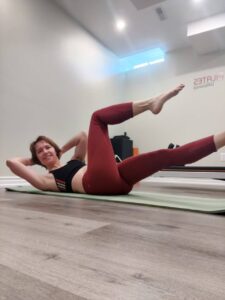If you’re in your 40s and suddenly noticing more stiffness, aches, or soreness in your hips, knees, or shoulders, you’re not alone. Many women in perimenopause experience joint pain that seems to appear out of nowhere. The truth is, this discomfort often isn’t “just aging” – it’s closely tied to hormone balance in perimenopause. Understanding this connection can help you find relief and regain confidence in your body as well as learn how pilates training can help this issue.
Why Hormones Affect Your Joints
One of the key hormones that influences joint health is estrogen. Estrogen doesn’t just regulate menstrual cycles – it also helps reduce inflammation, supports joint lubrication, and maintains collagen, which provides strength and elasticity to connective tissues. During perimenopause, when estrogen levels fluctuate and begin to decline, these protective benefits weaken. The result? More inflammation, stiffness, and discomfort in the joints.
Another factor is cortisol, the body’s stress hormone. Stress levels often rise during perimenopause, and higher cortisol contributes to inflammation and muscle tension. Combined with reduced estrogen, this creates the “perfect storm” for joint pain. Add in sleep disruption (another common symptom of hormonal shifts), and your body’s ability to repair tissues and recover from everyday activities is further compromised. There could be other causes that impact your joints health that you can learn from this article from Women’s Health Network.
Common Symptoms Women Notice
-
Morning stiffness or feeling “creaky” after sitting
-
Increased soreness in hips, knees, or shoulders
-
Longer recovery time after workouts
-
More frequent flare-ups of back or neck pain
These changes can be frustrating – especially for women who want to stay active and feel strong. But the good news is, there are ways to support your body and reduce discomfort.
How Pilates Training Can Help
Movement is one of the most powerful tools for restoring comfort and confidence. Pilates training is especially effective because it emphasizes functional movement, joint mobility, and core strength. Unlike high-impact exercise, Pilates is low-impact and joint-friendly, making it an excellent option for women navigating hormonal changes.
Here’s how Pilates helps with hormone-related joint pain:
-
Improves circulation: Gentle, controlled movements reduce stiffness and bring nutrients to joint tissues.
-
Strengthens stabilizing muscles: A strong core and hip support take pressure off the joints, particularly in the lower back, hips, and knees.
-
Enhances flexibility: Stretching and mobility work restore fluid movement and ease tightness.
-
Supports stress relief: Focused breathing and mindful movement help lower cortisol, reducing inflammation and tension.
The Bigger Picture: Supporting Hormone Balance
While exercise is essential, joint health during perimenopause also benefits from a holistic approach:
-
Staying hydrated and eating anti-inflammatory foods (such as omega-3 rich fish, berries, and leafy greens)
-
Prioritizing sleep to aid tissue repair
-
Practicing stress management techniques like meditation, yoga, or mindful breathing
-
Considering professional guidance to support hormone balance in perimenopause
Final Thoughts
Joint pain during perimenopause can feel discouraging, but it’s not something you have to accept as “just part of getting older.” By understanding the connection between hormones and joint health, you can take proactive steps to feel better. Pilates training offers a safe, effective way to reduce discomfort, improve mobility, and restore confidence in your body.
If you’re struggling with stiffness or soreness, remember – your body isn’t broken. With the right movement and support, you can feel strong, flexible, and in control of your health again. Contact us to learn about our Pilates training programs that can help you move with ease and help you navigate through this life stage.

this article over 40 spoke to me. when can I start my beginner Pilates journey.
can I drop in and try one of your group classes after 5:30 weekdays
please contact